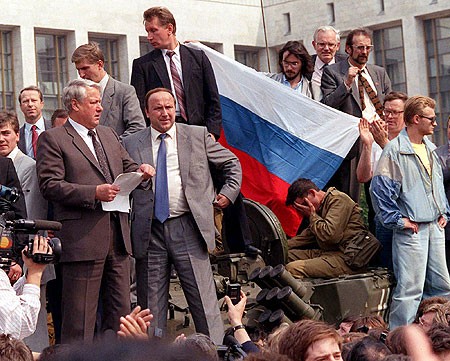The collapse of the Soviet Union in December 1991 marked a pivotal moment in world history, ending the decades-long Cold War and dramatically reshaping the global political landscape. Understanding why this superpower, seemingly invincible, suddenly dissolved is a complex question with no single, simple answer. Several interconnected factors, ranging from internal pressures to external influences, contributed to the unraveling of the USSR.
Following his inauguration in 1989, President George H.W. Bush initiated a strategic policy review regarding the Soviet Union, diverging from his predecessor Ronald Reagan’s approach to Mikhail Gorbachev. This reassessment aimed to establish a unique strategy for engaging with the USSR and navigating arms control negotiations during a period of significant global change.

The landscape in Eastern Europe and within the Soviet Union itself was rapidly transforming. Gorbachev’s decision to loosen the Soviet grip on Eastern European nations unleashed a wave of democratic fervor. This momentum culminated in the iconic fall of the Berlin Wall in November 1989, followed by the swift dismantling of Communist regimes across Eastern Europe. While the Bush administration supported these movements towards independence, their policy remained largely reactive, carefully avoiding actions that could destabilize Gorbachev’s position.
With the strategic review concluded, and acknowledging the accelerating changes in Europe, Bush and Gorbachev convened in Malta in December 1989. This summit laid the groundwork for crucial agreements, including the START treaty, the Conventional Forces in Europe treaty, and provided a platform to discuss the dramatic shifts occurring in Eastern Europe. Bush voiced support for Gorbachev’s reform initiatives, expressing hope that the Soviet leader could successfully guide the USSR toward a more democratic system and a market-based economy.
Gorbachev’s reforms, including the introduction of multi-party elections and the establishment of a Soviet presidency, initiated a gradual democratization process. However, this process ultimately weakened Communist control and played a significant role in the eventual collapse of the Soviet Union. The elections of May 1990 revealed the growing internal political tensions. Boris Yeltsin and the burgeoning pluralist movement championed democratization and rapid economic reforms, while the entrenched Communist hardliners resisted Gorbachev’s reform agenda, seeking to maintain the status quo.
Faced with the widening divide between Yeltsin and Gorbachev, the Bush administration chose to primarily engage with Gorbachev. He was perceived as the more dependable partner, particularly given his willingness to make concessions that aligned with U.S. interests. Progress continued on the START agreement. Gorbachev also agreed to the reunification of Germany and, acknowledging the shifting geopolitical realities, consented to a unified Germany’s membership in NATO following the withdrawal of Red Army troops from East Germany. Furthermore, when Iraq, under Saddam Hussein, invaded Kuwait, the United States and the Soviet Union cooperated diplomatically to address this international crisis.
Despite these positive developments on the international front, Gorbachev’s domestic challenges intensified. Growing pressures on Moscow’s authority strained Gorbachev and the Communist party’s ability to maintain power and preserve the Soviet Union’s territorial integrity. Following the collapse of Communist governments in Eastern Europe, the Baltic States and regions in the Caucasus increasingly voiced demands for independence from Moscow. In January 1991, violent clashes erupted in Lithuania and Latvia as Soviet tanks were deployed to suppress democratic uprisings, actions that were strongly condemned by the Bush administration.
By 1991, the escalating turmoil within the Soviet Union prompted the Bush administration to reassess its policy options once again. Three primary approaches emerged. The first was to continue supporting Gorbachev, hoping to prevent the disintegration of the Soviet Union. Alternatively, the U.S. could shift its support towards Yeltsin and the leaders of the various Republics, potentially facilitating a controlled restructuring or even a breakup of the USSR. The final option involved offering conditional support to Gorbachev, leveraging aid and assistance in exchange for more accelerated and radical political and economic reforms.
Uncertain about the extent of Gorbachev’s remaining political influence, Bush opted for a strategy that combined elements of the second and third options. The vast Soviet nuclear arsenal and substantial conventional military forces were significant concerns, and further weakening Gorbachev risked jeopardizing ongoing arms control negotiations. To balance U.S. interests with the evolving situation in the Soviet Union and to demonstrate continued support for Gorbachev, Bush signed the START treaty at the Moscow Summit in July 1991. Simultaneously, Bush administration officials increased their engagement with Yeltsin, recognizing his growing influence.
The attempted coup against Gorbachev in August 1991, orchestrated by hardline Communists, ultimately sealed the Soviet Union’s fate. Although unsuccessful, the coup significantly weakened Gorbachev’s authority and propelled Yeltsin and democratic forces to the forefront of Soviet and Russian politics. President Bush publicly denounced the coup as “extra-constitutional,” but Gorbachev’s diminished position was undeniable. He subsequently resigned as head of the Communist party, separating party power from the Soviet presidency. The Central Committee was dissolved, and Yeltsin effectively banned party activities. In the aftermath of the coup, Ukraine and Belarus declared their independence, joining the Baltic States, which had previously declared independence and were seeking international recognition.
Amidst the rapid and dramatic transformations unfolding across the Soviet Union, the Bush administration prioritized preventing nuclear catastrophe, managing ethnic conflicts, and ensuring a stable transition to new political structures. On September 4, 1991, Secretary of State James Baker outlined five guiding principles for U.S. policy toward the emerging republics: self-determination consistent with democratic principles, recognition of existing borders, support for democracy and the rule of law, protection of human rights and minority rights, and adherence to international law and obligations. The message was clear: republics adhering to these principles could expect cooperation and assistance from the United States. Baker met with both Gorbachev and Yeltsin to address the deteriorating economic situation and explore avenues for economic cooperation between Russia and the republics, as well as to facilitate peaceful and regulated political reforms. In early December, Yeltsin and the leaders of Ukraine and Belarus met in Brest, forming the Commonwealth of Independent States (CIS) and effectively declaring the Soviet Union defunct.
On December 25, 1991, the Soviet hammer and sickle flag was lowered for the final time over the Kremlin, replaced by the Russian tricolor. Earlier that day, Mikhail Gorbachev resigned as President of the Soviet Union, leaving Boris Yeltsin as the president of the newly independent Russian state. The world watched in astonishment as this relatively peaceful transition transformed a former Communist monolith into a collection of independent nations.
Following the dissolution of the Soviet Union, the Bush administration’s primary objectives were economic and political stability and security for Russia, the Baltic states, and the newly independent states of the former USSR. Bush formally recognized all twelve independent republics and established diplomatic relations with Russia, Ukraine, Belarus, Kazakhstan, Armenia, and Kyrgyzstan. In February 1992, Secretary Baker visited the remaining republics, establishing diplomatic ties with Uzbekistan, Moldova, Azerbaijan, Turkmenistan, and Tajikistan. Civil war in Georgia delayed its recognition and diplomatic relations with the U.S. until May 1992. Yeltsin met with Bush at Camp David in February 1992, followed by a state visit to Washington in June. Leaders from Kazakhstan and Ukraine also visited Washington in May 1992.
During these visits to Washington, discussions between Yeltsin and Bush centered on politics, economic reforms, and security concerns. Securing the nuclear arsenal of the former Soviet Union and preventing nuclear weapons proliferation was of paramount importance. Secretary Baker assured that the United States would provide funding to secure nuclear, chemical, and biological weapons within the former Soviet territories. The Nunn-Lugar Act, establishing the Cooperative Threat Reduction Program in November 1991, was created to fund the dismantling of weapons in the former Soviet Union, in accordance with the START and INF Treaties and other agreements. Bush and Baker also collaborated with Yeltsin and international organizations like the World Bank and IMF to provide financial assistance and mitigate the risk of a humanitarian crisis in Russia.
In conclusion, the fall of the Soviet Union was a multifaceted event stemming from a combination of Gorbachev’s reform efforts, which unintentionally weakened the Communist system, the rise of nationalist sentiments within the republics, economic stagnation, and the assertive yet cautious policies of the United States under President George H.W. Bush. The August coup attempt served as the final catalyst, accelerating the disintegration process and paving the way for the emergence of independent nations from the ashes of the USSR. Understanding this complex interplay of internal and external factors is crucial to grasping the significance of this historical turning point.
